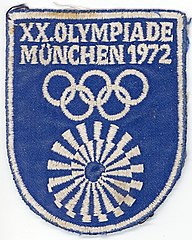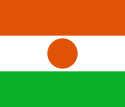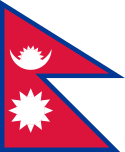Letnie Igrzyska Olimpijskie 1972
 Naszywka z godłem spirali | |
| Stolica igrzysk | |
|---|---|
| Liczba ekip | 121 |
| Liczba sportowców | 7132 |
| Liczba konkurencji | 195 w 23 dyscyplinach |
| Otwarcie | |
| Oficjalne otwarcie | prezydent RFN Gustav Heinemann |
| Zamknięcie | |
| Przysięga olimpijska | Heidi Schüller (sportowcy) |
| Znicz olimpijski | Günther Zahn |
| Stadion | |
XX Letnie Igrzyska Olimpijskie (oficjalnie Igrzyska XX Olimpiady) odbyły się w 1972 roku w Monachium (Niemcy Zachodnie). O organizację tych igrzysk starały się również miasta: Detroit (USA), Madryt (Hiszpania) i Montreal (Kanada). Podczas igrzysk doszło do zamachu terrorystycznego.
Państwa uczestniczące
|
Na Igrzyskach w Monachium zadebiutowało 11 państw: Albania, Arabia Saudyjska, Benin (jako Dahomej), Burkina Faso (jako Górna Wolta), Gabon, Korea Północna, Lesotho, Malawi, Somalia, Suazi i Togo
Otwarcie
Uroczystość otwarcia odbyła się 26 sierpnia 1972 roku na Stadionie Olimpijskim w Monachium. Uroczystego otwarcia dokonał Gustav Heinemann, prezydent RFN. Znicz olimpijski został zapalony przez niemieckiego lekkoatletę Günther Zahn.
Zamach
W trakcie igrzysk nastąpił zamach terrorystyczny. 5 września grupa Palestyńczyków z organizacji „Czarny Wrzesień” wdarła się przez mur do wioski olimpijskiej około godziny 4:00, zostali zauważeni przez pracowników poczty. Pracownicy ci, widząc grupę ubraną w dresy, pomyśleli, że są to sportowcy wracający z nocnej zabawy, dlatego nie włączali alarmu. Palestyńczycy weszli do budynku zamieszkiwanego przez izraelskich sportowców, których wzięli jako zakładników, zabijając przy tym dwóch, którzy stawili opór. Terroryści domagali się uwolnienia Palestyńczyków, przetrzymywanych w Izraelu. Po nieudanej akcji policjantów w strzelaninie zostało zabitych kolejnych 9 sportowców izraelskich, 5 terrorystów oraz jeden niemiecki policjant. Kolejnych trzech terrorystów aresztowano. Spodziewano się, że igrzyska zostaną zamknięte, co jednak nie nastąpiło (Avery Brundage wyraził swoje stanowisko słowami „The games must go on” (Zawody muszą trwać dalej)).
Maskotka
Po raz pierwszy na letnich igrzyskach olimpijskich została oficjalnie zaprezentowana maskotka igrzysk, był nim jamnik Waldi w kolorach: niebieski, pomarańczowy i zielony. Od tej pory na każdych kolejnych igrzyskach była prezentowana maskotka igrzysk[1].
Wyniki zawodów
Dyscypliny pokazowe
Medale zdobyte przez Polaków
 Złote
Złote
- Jan Szczepański – boks – waga lekka
- Władysław Komar – lekkoatletyka – pchnięcie kulą
- Zygmunt Smalcerz – podnoszenie ciężarów – waga musza
- Józef Zapędzki – strzelectwo – pistolet szybkostrzelny
- Witold Woyda – szermierka – floret
- Zygmunt Anczok, Lesław Ćmikiewicz, Kazimierz Deyna, Robert Gadocha, Zbigniew Gut, Jerzy Gorgoń, Andrzej Jarosik, Kazimierz Kmiecik, Hubert Kostka, Jerzy Kraska, Grzegorz Lato, Włodzimierz Lubański, Joachim Marx, Zygmunt Maszczyk, Marian Ostafiński, Marian Szeja, Zygfryd Szołtysik, Antoni Szymanowski, Ryszard Szymczak – piłka nożna, trener – Kazimierz Górski
- Lech Koziejowski, Witold Woyda, Marek Dąbrowski, Arkadiusz Godel, Jerzy Kaczmarek – szermierka – floret drużynowo
 Srebrne
Srebrne
- Wiesław Rudkowski – boks – waga lekkośrednia
- Antoni Zajkowski – judo – waga lekka
- Edward Barcik, Lucjan Lis, Stanisław Szozda, Ryszard Szurkowski – kolarstwo szosowe – wyścig drużynowy na 100 km
- Irena Szydłowska – łucznictwo – wielobój
- Norbert Ozimek – podnoszenie ciężarów – waga półciężka
 Brązowe
Brązowe
- Leszek Błażyński – boks – waga musza
- Janusz Gortat – boks – waga półciężka
- Rafał Piszcz, Władysław Szuszkiewicz – kajakarstwo – dwójka 1000 m
- Andrzej Bek, Benedykt Kocot – kolarstwo torowe – tandemy
- Ryszard Katus – lekkoatletyka, dziesięciobój
- Irena Szewińska – lekkoatletyka – bieg na 200 metrów
- Zbigniew Kaczmarek – podnoszenie ciężarów– waga lekka
- Kazimierz Lipień – zapasy – styl klasyczny, waga piórkowa
- Czesław Kwieciński – zapasy – styl klasyczny, waga półciężka
Klasyfikacja medalowa
| Klasyfikacja medalowa | |||||
| Lp. | Państwo | Łącznie | |||
|---|---|---|---|---|---|
| 1 | 50 | 27 | 22 | 99 | |
| 2 | 33 | 31 | 30 | 94 | |
| 3 | 20 | 23 | 23 | 66 | |
| 4 | 13 | 11 | 16 | 40 | |
| 5 | 12 | 8 | 8 | 28 | |
| 6 | 8 | 7 | 2 | 17 | |
| 7 | 7 | 5 | 9 | 21 | |
| 8 | 6 | 13 | 16 | 35 | |
| 9 | 6 | 10 | 5 | 21 | |
| 10 | 5 | 3 | 10 | 18 | |
| Zobacz pełną klasyfikację medalową | |||||
Zamknięcie
W Monachium na zakończenie wszyscy zawodnicy trzymali się za ręce w symbolicznym geście zbratania się wobec tragedii, jaka miała miejsce w trakcie igrzysk.
Przypisy
- ↑ Maria Rotkiewicz: Symbole i Maskotki Olimpijskie (pol.). olimpijski.pl. [dostęp 2016-06-11].
Bibliografia
- Oficjalny raport olimpijski z Letnich Igrzysk Olimpijskich 1972 w Monachium – cz. I. library.la84.org. [zarchiwizowane z tego adresu (2018-06-19)]. [dostęp: 16 października 2016].
- Oficjalny raport olimpijski z Letnich Igrzysk Olimpijskich 1972 w Monachium – cz. II. library.la84.org. [zarchiwizowane z tego adresu (2018-06-19)]. [dostęp: 16 października 2016].
- Oficjalny raport olimpijski z Letnich Igrzysk Olimpijskich 1972 w Monachium – cz. III. library.la84.org. [zarchiwizowane z tego adresu (2018-10-06)]. [dostęp: 16 października 2016].
- Letnie Igrzyska Olimpijskie 1972 w Monachium w bazie sports-reference.com. sports-reference.com. [zarchiwizowane z tego adresu (2010-08-28)]. [dostęp: 16 października 2016].
Media użyte na tej stronie
Olympic Rings without "rims" (gaps between the rings), As used, eg. in the logos of the 2008 and 2016 Olympics. The colour scheme applied here pertains to the 2016 Olympics in Rio de Janeiro.
Olympic Rings without "rims" (gaps between the rings), As used, eg. in the logos of the 2008 and 2016 Olympics. The colour scheme applied here pertains to the 2016 Olympics in Rio de Janeiro.
Autor: https://phabricator.wikimedia.org/diffusion/GOJU/browse/master/AUTHORS.txt, Licencja: MIT
An icon from the OOjs UI MediaWiki lib.
Autor: https://phabricator.wikimedia.org/diffusion/GOJU/browse/master/AUTHORS.txt, Licencja: MIT
An icon from the OOjs UI MediaWiki lib.
Autor: Scroch, Licencja: CC BY-SA 3.0
Flag of Bulgaria (1971-1990). Flag of Bulgaria with Bulgarian coat from 1971.
Łatwo można dodać ramkę naokoło tej grafiki
The flag of the Dominican Republic has a centered white cross that extends to the edges. This emblem is similar to the flag design and shows a bible, a cross of gold and 6 Dominican flags. There are branches of olive and palm around the shield and above on the ribbon is the motto "Dios,Patria!, Libertad" ("God, Country, Freedom") and to amiable freedom. The blue is said to stand for liberty, red for the fire and blood of the independence struggle and the white cross symbolized that God has not forgotten his people. "Republica Dominicana". The Dominican flag was designed by Juan Pablo Duarte, father of the national Independence of Dominican Republic. The first dominican flag was sewn by a young lady named Concepción Bona, who lived across the street of El Baluarte, monument where the patriots gathered to fight for the independence, the night of February 27th, 1844. Concepción Bona was helped by her first cousin María de Jesús Pina.
Flaga Finlandii
Autor: SanchoPanzaXXI, Licencja: CC BY-SA 4.0
Flag of Spain during the Spanish State. It was adopted on 11 October 1945 with Reglamento de Banderas Insignias y Distintivos (Flags, Ensigns and Coats of Arms Bill)
The Flag of India. The colours are saffron, white and green. The navy blue wheel in the center of the flag has a diameter approximately the width of the white band and is called Ashoka's Dharma Chakra, with 24 spokes (after Ashoka, the Great). Each spoke depicts one hour of the day, portraying the prevalence of righteousness all 24 hours of it.
bendera Indonesia
New Version of ا:Image:Lionflag.svg with a cleaner emblem and the correct ratio.
Flag of Israel. Shows a Magen David (“Shield of David”) between two stripes. The Shield of David is a traditional Jewish symbol. The stripes symbolize a Jewish prayer shawl (tallit).
Flag of Jamaica. “The sunshine, the land is green, and the people are strong and bold” is the symbolism of the colours of the flag. GOLD represents the natural wealth and beauty of sunlight; GREEN represents hope and agricultural resources; BLACK represents the strength and creativity of the people. The original symbolism, however, was "Hardships there are, but the land is green, and the sun shineth", where BLACK represented the hardships being faced.
Variant version of a flag of Japan, used between January 27, 1870 and August 13, 1999 (aspect ratio 7:10).
Flag of the Socialist Federal Republic of Yugoslavia (1946-1992).
The design (blazon) is defined in Article 4 of the Constitution for the Republic of Yugoslavia (1946). [1]
Flag of the Socialist Federal Republic of Yugoslavia (1946-1992).
The design (blazon) is defined in Article 4 of the Constitution for the Republic of Yugoslavia (1946). [1]
Flag of the People's Republic of Congo between 1 January 1970 - 10 June 1991
Flag of Liechtenstein
Please do not replace the simplified code by a version created with Inkscape or another vector graphics editor❗
Flag of New Zealand. Specification: http://www.mch.govt.nz/nzflag/description.html , quoting New Zealand Gazette, 27 June 1902.
Flaga Rzeczypospolitej Polskiej, a później Polskiej Rzeczypospolitej Ludowej w okresie 1928-1980 ustanowiona rozporządzeniem Prezydenta Rzeczypospolitej z dnia 13 grudnia 1927 r. o godłach i barwach państwowych oraz o oznakach, chorągwiach i pieczęciach, Dz. U. z 1927 r. Nr 115, poz. 980 i potwierdzona dekretem z dnia 9 listopada 1955 r. o znakach Sił Zbrojnych, Dz. U. z 1955 r. Nr 47, poz. 315.
Do odwzorowania barwy czerwonej użyto domyślnego odcienia "vermilion" (#E34234, cynober). Proporcje 5:8 (w dekrecie z 1955 roku błędnie ustalone jako 3:8, skorygowane w obwieszczeniu Prezesa Rady Ministrów z dnia 20 lutego 1956 r. o sprostowania błędu w dekrecie z dnia 7 grudnia 1955 r. o godle i barwach Polskiej Rzeczypospolitej Ludowej oraz o pieczęciach państwowych, Dz.U. z 1955 r. Nr 47 poz. 314).
Flaga Rzeczypospolitej Polskiej, a później Polskiej Rzeczypospolitej Ludowej w okresie 1928-1980 ustanowiona rozporządzeniem Prezydenta Rzeczypospolitej z dnia 13 grudnia 1927 r. o godłach i barwach państwowych oraz o oznakach, chorągwiach i pieczęciach, Dz. U. z 1927 r. Nr 115, poz. 980 i potwierdzona dekretem z dnia 9 listopada 1955 r. o znakach Sił Zbrojnych, Dz. U. z 1955 r. Nr 47, poz. 315.
Do odwzorowania barwy czerwonej użyto domyślnego odcienia "vermilion" (#E34234, cynober). Proporcje 5:8 (w dekrecie z 1955 roku błędnie ustalone jako 3:8, skorygowane w obwieszczeniu Prezesa Rady Ministrów z dnia 20 lutego 1956 r. o sprostowania błędu w dekrecie z dnia 7 grudnia 1955 r. o godle i barwach Polskiej Rzeczypospolitej Ludowej oraz o pieczęciach państwowych, Dz.U. z 1955 r. Nr 47 poz. 314).
Flag of Portugal, created by Columbano Bordalo Pinheiro (1857-1929), officially adopted by Portuguese government in June 30th 1911 (in use since about November 1910). Color shades matching the RGB values officially reccomended here. (PMS values should be used for direct ink or textile; CMYK for 4-color offset printing on paper; this is an image for screen display, RGB should be used.)
Flag of Romania, (21 August 1965 - 22 December 1989/officialy 27 December 1989).
Construction sheet of the Flag of Romania as depicted in Decree nr. 972 from 5 November 1968.
- l = 2/3 × L
- C = 1/3 × L
- S = 2/5 × l
Flag of Romania, (21 August 1965 - 22 December 1989/officialy 27 December 1989).
Construction sheet of the Flag of Romania as depicted in Decree nr. 972 from 5 November 1968.
- l = 2/3 × L
- C = 1/3 × L
- S = 2/5 × l
Flag of Senegal
The flag of Navassa Island is simply the United States flag. It does not have a "local" flag or "unofficial" flag; it is an uninhabited island. The version with a profile view was based on Flags of the World and as a fictional design has no status warranting a place on any Wiki. It was made up by a random person with no connection to the island, it has never flown on the island, and it has never received any sort of recognition or validation by any authority. The person quoted on that page has no authority to bestow a flag, "unofficial" or otherwise, on the island.
The national flag of Kingdom of Thailand since September 2017; there are total of 3 colours:
- Red represents the blood spilt to protect Thailand’s independence and often more simply described as representing the nation.
- White represents the religion of Buddhism, the predominant religion of the nation
- Blue represents the monarchy of the nation, which is recognised as the centre of Thai hearts.
State Flag of Venezuela 1930-2006, New flag was introduced 13 March 2006.
Flag of the Ivory Coast, written by Jon Harald Søby, modified by Zscout370. The colors match to what is reported at http://fotw.vexillum.com/flags/ci.html.
(c) I, Cmapm, CC-BY-SA-3.0
The flag of the Soviet Union (1955-1991) using a darker shade of red.
Pictograms of Olympic sports - Boxing. This is unofficial sample picture. Images of official Olympic pictograms for 1948 Summer Olympics and all Summer Olympics since 1964 can be found in corresponding Official Reports.
Pictograms of Olympic sports - Gymnastics (artistic). This is unofficial sample picture. Images of official Olympic pictograms for 1948 Summer Olympics and all Summer Olympics since 1964 can be found in corresponding Official Reports.
Pictograms of Olympic sports - Field hockey. This is unofficial sample picture. Images of official Olympic pictograms for 1948 Summer Olympics and all Summer Olympics since 1964 can be found in corresponding Official Reports.
Pictograms of Olympic sports - Judo. This is unofficial sample picture. Images of official Olympic pictograms for the 1948 Summer Olympics and all Summer Olympics since 1964 can be found in corresponding Official Reports.
Pictograms of Olympic sports - Cycling (road). This is unofficial sample picture. Images of official Olympic pictograms for 1948 Summer Olympics and all Summer Olympics since 1964 can be found in corresponding Official Reports.
Pictograms of Olympic sports - Basketball. This is unofficial sample picture. Images of official Olympic pictograms for 1948 Summer Olympics and all Summer Olympics since 1964 can be found in corresponding Official Reports.
Pictograms of Olympic sports – . This is an unofficial sample picture. Images of official Olympic pictograms for 1948 Summer Olympics and all Summer Olympics since 1964 can be found in corresponding Official Reports.
Pictograms of Olympic sports - Archery. This is unofficial sample picture. Images of official Olympic pictograms for 1948 Summer Olympics and all Summer Olympics since 1964 can be found in corresponding Official Reports.
Pictograms of Olympic sports - Modern pentathlon. This is unofficial sample picture. Images of official Olympic pictograms for 1948 Summer Olympics and all Summer Olympics since 1964 can be found in corresponding Official Reports.
Pictograms of Olympic sports - Football. This is unofficial sample picture. Images of official Olympic pictograms for 1948 Summer Olympics and all Summer Olympics since 1964 can be found in corresponding Official Reports.
Pictograms of Olympic sports - Handball. This is unofficial sample picture. Images of official Olympic pictograms for 1948 Summer Olympics and all Summer Olympics since 1964 can be found in corresponding Official Reports.
Pictograms of Olympic sports - Water polo. This is unofficial sample picture. Images of official Olympic pictograms for 1948 Summer Olympics and all Summer Olympics since 1964 can be found in corresponding Official Reports.
Pictograms of Olympic sports - Swimming. This is unofficial sample picture. Images of official Olympic pictograms for 1948 Summer Olympics and all Summer Olympics since 1964 can be found in corresponding Official Reports.
Pictograms of Olympic sports - Weightlifting. This is unofficial sample picture. Images of official Olympic pictograms for 1948 Summer Olympics and all Summer Olympics since 1964 can be found in corresponding Official Reports.
Pictograms of Olympic sports - Volleyball (indoor). This is unofficial sample picture. Images of official Olympic pictograms for 1948 Summer Olympics and all Summer Olympics since 1964 can be found in corresponding Official Reports.
Pictograms of Olympic sports - Diving. This is unofficial sample picture. Images of official Olympic pictograms for 1948 Summer Olympics and all Summer Olympics since 1964 can be found in corresponding Official Reports.
Pictograms of Olympic sports - Shooting. This is unofficial sample picture. Images of official Olympic pictograms for 1948 Summer Olympics and all Summer Olympics since 1964 can be found in corresponding Official Reports.
Pictograms of Olympic sports - Fencing. This is unofficial sample picture. Images of official Olympic pictograms for 1948 Summer Olympics and all Summer Olympics since 1964 can be found in corresponding Official Reports.
Pictograms of Olympic sports - Rowing. This is unofficial sample picture. Images of official Olympic pictograms for 1948 Summer Olympics and all Summer Olympics since 1964 can be found in corresponding Official Reports.
Pictograms of Olympic sports - Wrestling. This is unofficial sample picture. Images of official Olympic pictograms for 1948 Summer Olympics and all Summer Olympics since 1964 can be found in corresponding Official Reports.
Autor: B1mbo, Licencja: CC BY-SA 2.5
Drawing of a gold medal, based on Olympic rings.svg.
Autor: B1mbo, Licencja: CC BY-SA 2.5
Draw of a silver medal, based in Olympic rings.svg.
- The joining of the rings is not correct drawn.
Autor: B1mbo, Licencja: CC BY-SA 2.5
Drawing of a bronze medal, based on Olympic rings.svg.
Flag of Tunisia until 1999.
The flag of the Ethiopian Empire with the Lion of Judah in the center
(c) Zscout370 z angielskiej Wikipedii, CC-BY-SA-3.0
The first flag of the nation of Lesotho, used from 1966 until 1987. Elements from this flag can be seen on the current national flag, in use starting in 2006.
Made by author of Xramp, first uploaded by Denelson83 as Flag of Ecuador.svg, modifications by Husunqu.
Autor: Heraldry, Licencja: CC-BY-SA-3.0
Flag of British Honduras
Flag of Zambia before 1996
Flag of People's Republic of Mongolia 1945-1992
Pictograms of Olympic sports - Sailing. This is unofficial sample picture. Images of official Olympic pictograms for 1948 Summer Olympics and all Summer Olympics since 1964 can be found in corresponding Official Reports.
Flag of Italy from 1946 to 2003, when exact colors were specified.
Flag of South Korea (1949-1984)
Flag of Suriname, constituent country of the Kingdom of the Netherlands (1954-1974), from its adoption in 1959 until the achievement of independence on 25 November 1975, on which date the flag was changed to its current form.
Autor: Richard Huber, Licencja: CC BY-SA 3.0
Deutschland, München, XX. Olympische Sommerspiele 1972, Aufnäher
Autor: Simitukidia and Lokal Profil, Licencja: CC BY-SA 3.0
Flag of Fiji from 1924 to 1970
Flaga Wietnamu Południowego
Pictograms of Olympic sports - Canoeing (slalom). This is unofficial sample picture. Images of official Olympic pictograms for 1948 Summer Olympics and all Summer Olympics since 1964 can be found in corresponding Official Reports.
Pictograms of Olympic sports (demonstration) – Water skiing.
The Egyptian flag (1972-1984). Also the flag of Libya (1972-1977) and Syria (1972-1980), when the three countries formed the nominal “Federation of Arab Republics”. (For a map of the federation, see Image:Esl.PNG.)
The Arab text in the scroll held by the “Golden Hawk of Qureish” reads Arabic اتحاد الجمهوريات العربية, ittiħād al-jumhūriyyāt al-`arabiyya, i.e. the Federation (literally “Union”) of Arab Republics — in a quasi-Kufic script (in its original form, with a very ornamental letter dal د).
Autor: Tcfc2349, Licencja: CC BY-SA 4.0
Flag of the Bahamas (1964-1973)
The flag of Afghanistan between 1931 and 1973 (1311–1352 A.P., 1351–1393 A.H.).
The flag of San Marino, before the 2011 standardization
Flag of Brazil (1968-1992)
Pictograms of Olympic sports - Badminton. This is unofficial sample picture. Images of official Olympic pictograms for 1948 Summer Olympics and all Summer Olympics since 1964 can be found in corresponding Official Reports.
Flag of Cameroon, 1961-75
Flag of Greece (1970–1975), adopted by the Greek military Junta; Aspect ratio: 7:12
Pictograma de los juegos ecuestres.
1910 Flag of Bermuda (with smaller coat of arms)




























































































































































